 Several years ago John Novosel released a book called “Tour Tempo.” The book has been a big help to many golfers, including those in the Reading Room section of our forum. The premise is that most PGA Tour players swing at about a 3:1 ratio, and that you should as well.
Several years ago John Novosel released a book called “Tour Tempo.” The book has been a big help to many golfers, including those in the Reading Room section of our forum. The premise is that most PGA Tour players swing at about a 3:1 ratio, and that you should as well.
The “Tour Tempo” training regimen involves swinging to a series of beeps, spaced at a 3:1 ratio and at whatever total speed best fit your personality. Though the practice undoubtedly helped some golfers, I personally found swinging to beeps to be annoying and ungratifying. Plus, so long as you hit the beeps at the right time, your swing was deemed to have good tempo, regardless of how quickly you snatched the club away at the start of your swing or how smoothly you accelerated from the top.
As a decent golfer, I realize the importance of tempo, but I’ve yet to discover a great way to teach and learn tempo. I was excited the first time I heard about Ph.D. scientist Dr. Bob Grober’s Sonic Golf system, which converts the rotational movement of the club into a sound gradient. Vijay Singh used it to win the 2008 Deutsche Bank tournament and the FedExCup, making the Sonic Golf system a legitimate $10M idea.
Read on to see what we thought of the Sonic Golf system.
The Equipment
The Sonic golf system is comprised of two main pieces: a transmitter and a receiver. The transmitter, or “SX-1,” slips inside of the butt end of your golf grips where it measures the rotation of your club and transmits the data to the “RX-1” receiver. The RX-1, which clips to your belt or slides into your pocket, has a minijack for headphones and translates the data received from the SX-1 into realtime audio.
The Sonic Golf system currently comes in two configurations. The “System-1 Solo Edition” comes with one each of the SX-1 and the RX-1 as well as three special Golf Pride Tour Velvet grips. The “System-1 Pro Edition” adds three grips (for a total of six) and a second RX-1. Both come with tape and headphones, a screwdriver, batteries, a roll of tape, a carrying case, and a training DVD. The Solo edition runs $399 and the Pro edition $599, but both have been offered for $100 off for quite some time ($299 and $499). Additional grips, tape, receivers, and transmitters are all available separately as well.
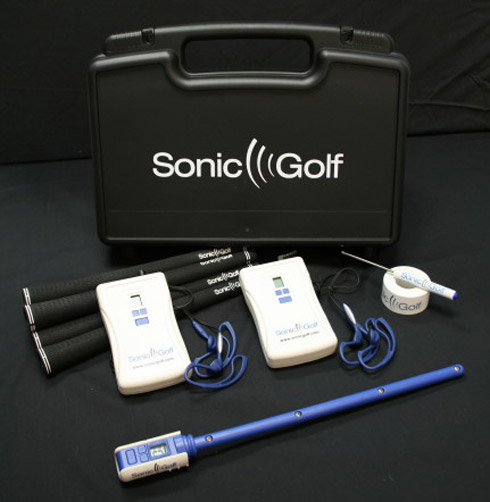
The Pro edition comes with six grips, two receivers, one transmitter, and all the little extras you’ll need. The Pro edition is intended for teachers who will want to listen to their students’ swings.
The Sonic Golf system comes with special Golf Pride Tour Velvet grips because the transmitter – the long, blue piece of equipment in the image above – won’t fit inside a normal golf grip. Instead, Sonic Golf worked with Golf Pride to produce grips with a special molded butt that receives the SX-1 transmitter.
If you normally play Tour Velvet grips, you won’t mind installing the special grips on your normal set of clubs at all. Unfortunately I use Golf Pride’s New Decade Multicompound grips, so I installed three of my six grips on a backup wedge, 6-iron, and driver. It’s less than an ideal solution, but perhaps Sonic Golf will one day become so large that they can talk Golf Pride into making a full line of specialized grips.
Operating the Sonic Golf system is simple: you turn the transmitter on by pressing the power button, set the channel to any one of the eight available, and do the same on as many receivers as you’d like to listen. You slide the transmitter into the special Golf Pride grip, clip the receiver to your belt or slip it into a back pocket, and put the headphones in your ears.
The size of the receiver presents a minor issue. It’s noticeably bulky (4.5 x 2.8 x 1″) and noticeably heavy at 5.58 ounces. Compare this with an iPod Nano at 3.6″ x 1.5″ x 0.24″ and 1.28 ounces and you’ll start to understand how bulky the Sonic Golf receiver is in comparison (while having a much shorter list of features).
Performance and Practicality
The size of the receiver is but one of a few stumbling blocks apparent in this first-generation product. Each issue is small, but depending on how sensitive you are to these types of things and how you use your Sonic Golf system, they can add up.
The first and second I’ve already mentioned: you’ve got to install custom grips on your clubs, and if you don’t use Tour Velvet grips, you may be installing them on a backup set, and the size and weight of the receiver.
The third involves the roll of tape that comes with each system. You’re supposed to wrap tape around four places on the transmitter so that it fits snugly into your shaft(s). Unfortunately, the inner diameter of your shafts likely changes from club to club, so as you swap the transmitter from your driver to your six-iron, you’re regularly adding tape, removing tape, and checking the fit. It’s a time-intensive operation that interrupts practice sessions. Why couldn’t the smart folks at Sonic Golf build in some sort of foam or spring-loaded system?
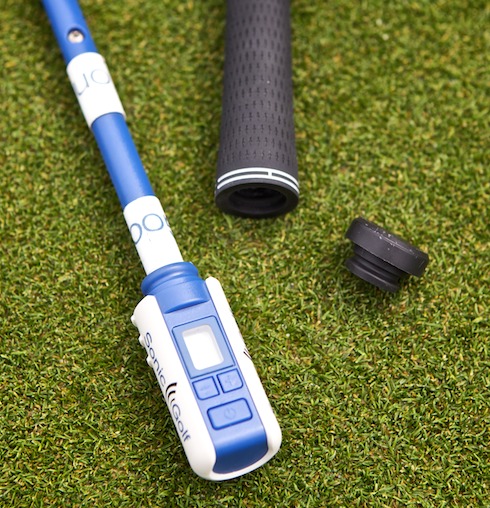
The transmitter and the custom-made Golf Pride Tour Velvet grip. The transmitter clicks into the notch on the butt end of the grip which, along with the tape, holds the transmitter securely in the club.
Once you’ve got your grips installed and the transmitter taped up, you’re ready to start swinging. The premise is simple: you’re supposed to use the sound produced by the Sonic Golf system to fine-tune your overall tempo as well as a few key spots in the golf swing. Your tempo is translated into realtime sounds in a practical fashion: slower movements produce a lower-pitched, quieter sound. Faster movements produce a higher-pitched, louder sound. Easy.
Though at first it was disconcerting hitting balls while I a shifting tonal gradient played in my ears, I quickly adapted and began focusing on producing a proper “swing sound” – a term my instructor and I came up with to describe the sounds.
Prior to working with the Sonic Golf system, my instructor and I identified several areas where tempo could be measured and improved upon fairly easily. We came up with three key areas – one at each phase of the golf swing – and began testing the efficacy of the Sonic Golf system at identifying and eliminating problems in these areas.
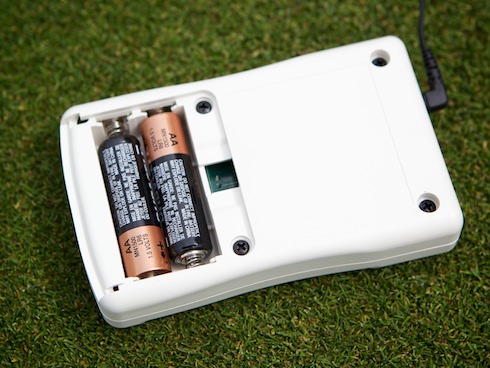
The RX-1 receiver requires two AA batteries. Though it fits into a pants pocket, the size is quite a bit larger than you’d expect, particularly when you consider how small cell phones can be.
Takeaway
The first potential problem area is the takeaway. I’ve always had a fairly fast tempo, and we weren’t looking to change that. But sometimes I take the club away from the ball a bit too quickly. I’ve tried a lot of things to fix this problem, but none work for very long because it’s incredibly boring to practice a slow takeaway and incredibly easy to forget while you’re working on something else or out on the course.
With the Sonic Golf system, I didn’t have to remember anything. Instead, I simply worked on something else in my golf swing while listening for a good takeaway “in the background.” With a good takeaway – a gradual building of pitch and volume – I’d simply ignore the sounds and hit the golf ball. But if the volume and pitch shot up too quickly, I could stop the swing immediately and re-start thanks to the instant feedback.
Transition at the Top
The second area we identified was at the top of the backswing. Some players pause longer than others at the top, but nearly every player will see a substantial drop in volume and pitch as their club reaches the top of their swing. My pause – though brief again thanks to my faster tempo – was pretty good, so we tried out a few other swing flaws and the practicality of the Sonic Golf system became evident.
Specifically, the system helps to identify two major problems with this portion of the swing: the loop and the jerk. The “loop” occurs when a golfer takes the club to the top and, rather than simply reverse the direction, loops the clubhead around. The shaft is still rotating (though not on the “proper” swing plane), so the Sonic Golf system still puts out sound. The “jerk” is a bit more obvious and is essentially the same as my takeaway problem. If you don’t accelerate smoothly from the top of the backswing, you’ll hear it a louder, higher-pitched noise than the ideal.
The third area we identified is impact, and specifically, achieving the loudest, highest-pitched sound right at the golf ball. Worse golfers tend to have the highest volume and pitch – and thus the highest clubhead speed – somewhere to their right, behind the golf ball. They’re casting and decelerating into the golf ball.
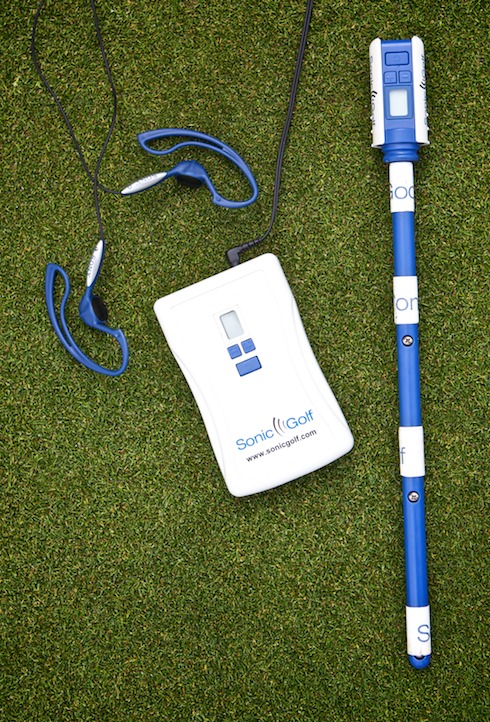
The RX-1 receiver with attached (and included) headphones and the SX-1 sensor/transmitter.
Lower handicappers, on the other hand, tend to get overdo the old “accelerate through the ball” swing thought. We’ve all seen the drill where you turn your driver around and make the grip go “whoosh” the loudest somewhere in front of the ball, right? It’s a great swing thought, but inefficient all the same – you want to accelerate to your maximum clubhead speed at the ball, not after the ball.
The Sonic Golf system makes finding and fixing problems in this stage of the swing easy. I discovered that my swing was reaching maximum speed at the golf ball pretty well, but my instructor wasn’t reaching his maximum speed until about 12 or 14 inches after the ball. Through practice, he adjusted and gained a few yards with his 6-iron, which might translate to eight to ten yards with his driver.
The Sonic Golf system works outside of the full swing as well. For 50-100 yard pitch shots, it can work wonders. A lot of golfers have reasonably good tempo with their full swings, then resort to jerking and pulling the club around with their less-than-full swings. If you lack consistency in the longer sections of the scoring zone, the Sonic Golf system may help you to diagnose any tempo problems that exist.
Inside of about 50 yards, you’ll find that you simply don’t move the club enough to get much sound from the Sonic Golf system. If you suffer from poor tempo in your shorter pitches, your chip shots, or your putting, you’re out of luck. Sonic Golf has developed a separate putting transmitter – I assume it will work with existing receivers – and is accepting pre-orders for shipment in early 2010. It’s disappointing that there’s not simply a switch to enable a shorter swing mode on the existing transmitter/sensor.
Conclusion
I’m a relatively good golfer, and I understand the importance of a good tempo. Though I believe the Sonic Golf system is the best tempo training aid on the market, and despite wanting to like it, I came out of the experience rather unexcited. At $299 even the Solo system is fairly costly, and the transmitter requires too much fiddling – backup clubs because of the special grips, messing with the tape – for my taste. It only really works on reasonably full swings and will require an additional few hundred dollars in the future (the current transmitter costs $219) if you want to work on your putting and short-game tempo.
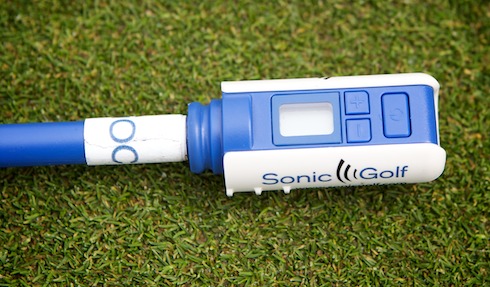
The SX-1 is easy to control. One button turns it on and off and two others change the channel.
My instructor is a bit more upbeat. At $500, he only has to use the Sonic Golf system in a few lessons per year to justify the cost. He can install a few grips on a few different 6-irons to suit the taste and ability of various golfers. He can plug the RX-1 receiver into his high-speed digital video camera to record the “swing sound” right along with video of his student’s swings to show them yet another dimension in which they’re improving (or need improvement).
Dr. Bob Grober seems to have taken a “do-it-yourself” approach to this invention, and though I admire the desire to go it alone, I’m left wondering if perhaps the approach isn’t hurting the product a little bit. The product still feels a bit like a technical demo or a proof of concept and not a finished product. I can’t help but feel that if Dr. Bob Grober had paired with an established golf company he might have a sleeker, easier-to-use, less costly device that might sell easily to individual golfers and instructors alike. Imagine how well an iPod Nano-sized receiver with a transmitter/sensor that worked on putting strokes and full swings and cost $199 for Solo and $329 for the Pro system might sell!
Though the Sonic Golf system is good start I believe the product may need a few revisions before it’s ready for the masses. The concept is good – the technology works and can help golfers and instructors to identify and correct tempo-related issues – but the implementation needs work. I’m left wanting more, and I hope to see it in future revisions to the system.

Did Vijay continue to use this tempo tool when he posted just 2 top tens this year???
Great review…I’ve always thought this was a great idea for a product, but wondered about the practicality of the usage.
I wonder why they can’t just transmit over an FM signal so the user can just use his favorite MP3 player with FM receiver. That could reduce the user cost. I totally agree that this is out of most people’s price range.
But, it sounds like the bigger issue is having extra (2nd set) clubs with the special grips. I would probably resort to only 2 clubs…7 iron and driver…or something to avoid all of the re-taping and re-fitting.
Thats why they need one for putting, his was not good this year. 🙄
The signal processing is likely in the receiver, too. I don’t think audio is sent from the transmitter – I think data is sent, translated to audio, and played back in the receiver.
I purchased the solo system a few weeks ago. I was pleasantly suprised to find that the training device actually matched its advertised claims.
Erik, your primary gripes have nothing to do with the effectiveness of the training aid in helping to develop a more robust and consistent golf swing, eg, didn’t like having to use the included grips, re-taping the transmitter. Based on my own experience getting the device ready for my clubs, I didn’t find these inconveniences to be significant .
This swing training device is the first one that has resulted in a significant improvement to my golf swing. I suspect at least part of the reason for this success is that it wasn’t sold to, developed, marketed and distributed by an established golf company. I have a number of those training aids sitting in my basement gathering dust.
No, they don’t. You are correct. However, I found the fact that I needed to use different clubs and that I needed to re-tape every time I wanted to switch clubs severely hampered my ability to get to the “effectiveness” of the system.
So if the Sonic Golf system were smaller, less expensive, and easier to use, it wouldn’t be as good? I think it’d be better, and would be more useful to more people. Again I admire the “go-it-alone” attitude of the Grobers, but I can’t help but think it’s led to some tradeoffs in the things I just mentioned.
Ahhh…makes sense